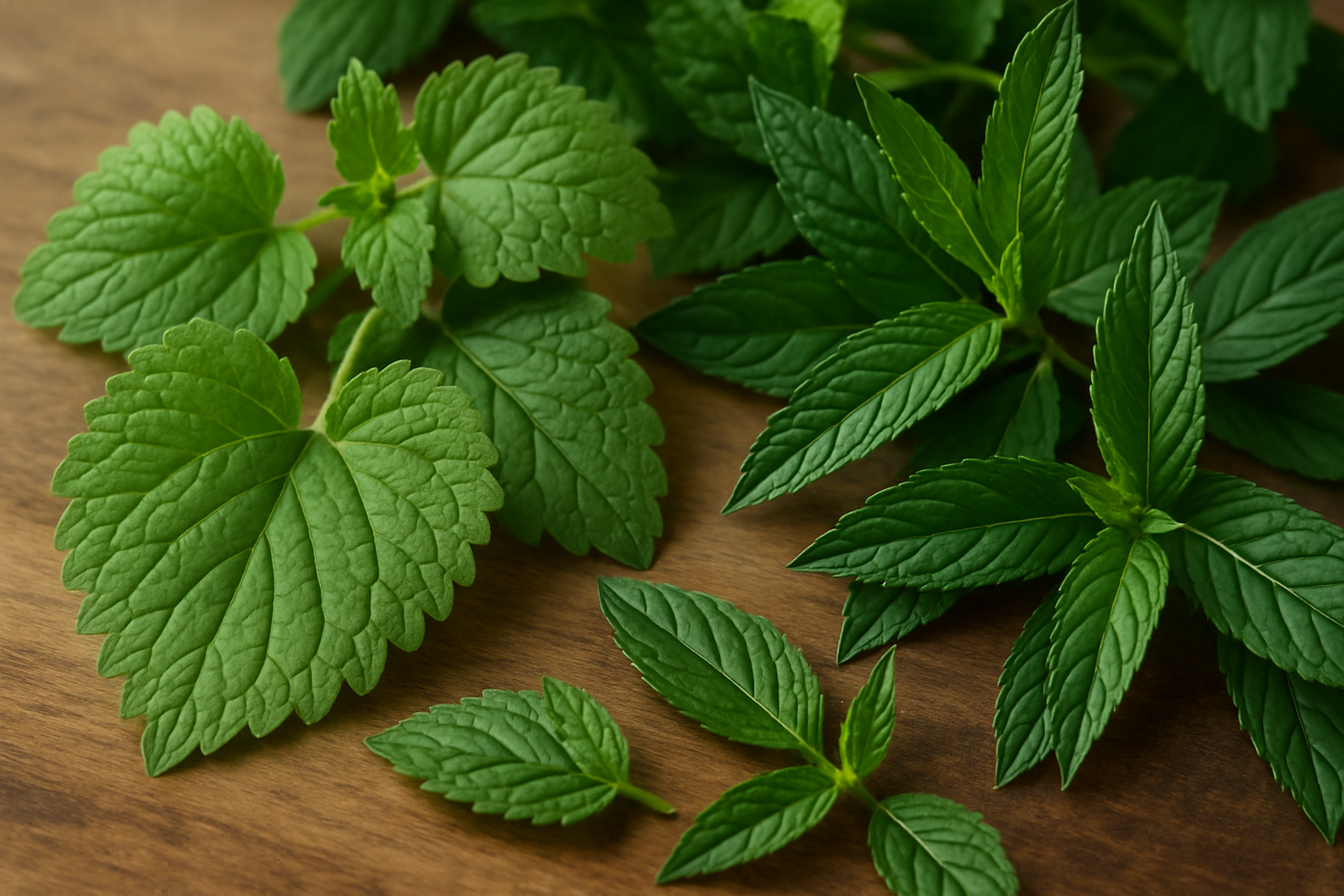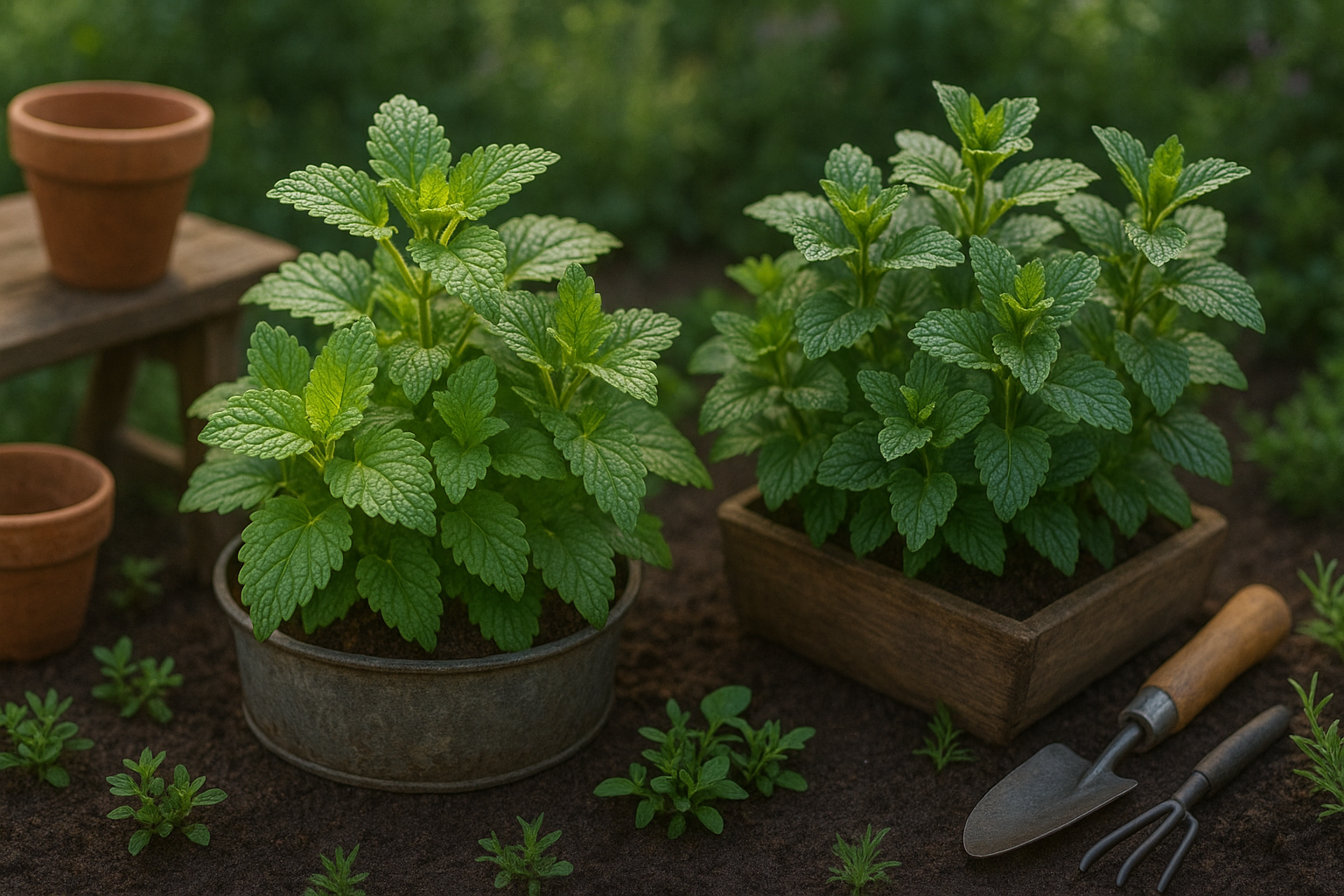Introduction
Lemon balm vs. mint—these fragrant herbs often get mixed up, and it’s easy to see why. Both bring a burst of green to gardens and kitchens, and their fresh, uplifting aromas can transform teas, salads, and desserts. But despite their similarities, lemon balm and mint are more than just twins in the herb world.
Understanding the differences between these two plants can save gardeners from a surprise harvest, help cooks select the right herb for a recipe, and guide herbal enthusiasts in choosing the best option for relaxation or remedy. In this post, we’ll break down what sets lemon balm and mint apart, starting with their distinct appearances and scents.
We’ll also explore each herb’s unique uses in cooking and wellness, as well as their preferred growing conditions—so you can decide which one belongs in your window box or garden bed. Whether you’re after soothing herbal tea or a punchy garnish, knowing the differences between lemon balm and mint will help you get the most out of these versatile plants.
What Are Lemon Balm and Mint? Key Characteristics Explained

Lemon balm and mint are two popular herbs that are often mistaken for each other, but they have distinct characteristics. Both belong to the Lamiaceae, or mint, family—a group known for aromatic plants with square stems and opposite leaves.
Lemon balm’s botanical name is Melissa officinalis, while common culinary mints include Mentha spicata (spearmint) and Mentha × piperita (peppermint).
Visually, lemon balm leaves are heart-shaped with softly serrated edges, a medium green color, and a slightly fuzzy texture. In contrast, mint leaves are more elongated, sharply toothed, and range from bright to deep green with a glossy surface.
When crushed, lemon balm exudes a fresh, lemony scent reminiscent of citrus, while mints produce a brisk, cool aroma—spearmint is sweet and light, whereas peppermint has a stronger, almost spicy menthol note.
Flavor-wise, lemon balm offers subtle lemon and herbal notes without the cooling sensation of mint; it’s gentle enough for teas or salad garnishes. Mint stands out for its refreshing, palate-cooling taste, making it popular in drinks, desserts, and savory dishes.
Native habitats further set them apart: lemon balm is native to Southern Europe and the Mediterranean, thriving in well-drained soils and sunny spots, while mints originally spread across Europe, Africa, and Asia, and are renowned for their vigorous growth in moist, partially shaded areas.
Both herbs can spread quickly, but mints are infamous for their rampant, sometimes invasive, underground runners—gardeners often plant them in pots or use barriers to keep them contained.
In summary, recognizing lemon balm and mint starts with observing their leaf shape, feeling the texture, and sniffing for distinctly lemony or minty fragrances—simple tips that make identification easy whether you’re in a garden, grocery store, or farmer’s market.
Comparing Uses
Culinary herbs like mint and basil have woven themselves into both traditional and modern kitchens around the world, with uses that go far beyond seasoning. Take mint, for example: a key ingredient in Moroccan tea, it brings a cooling freshness to summer salads, fruit desserts, and Mediterranean yogurt dips. Basil is just as versatile, starring in Italian pesto, Thai curries, or simply brightening up a Caprese salad.
While both herbs lend vibrant flavor, they aren’t always interchangeable in recipes. Basil’s peppery, sweet notes differ from mint’s menthol coolness, so swapping them may significantly alter the final taste—especially in classic dishes like basil pesto or mint chutney, where the herb’s essence is central.
Medicinally, mint is renowned for soothing an upset stomach and easing headaches, while basil has been prized in Ayurvedic medicine for its calming effects and ability to support the immune system. Both herbs find their way into wellness routines, from herbal teas that aid digestion or relieve stress to essential oils used in aromatherapy diffusers for mental clarity.
Beyond health, they offer beauty benefits: crushed mint can refresh the skin as a DIY face mask, and basil’s antibacterial oils are often found in natural soaps or remedies for blemishes. In the home, mint is sometimes used to deter pests or freshen the air, while basil-infused water can make a gentle, natural cleaner.
Whether you’re garnishing a dessert, brewing a calming cup of tea, or concocting a simple home remedy, it’s important to select the right herb for the job. Substitute only when the dish can tolerate a flavor change, such as a fruity salad or a homemade body scrub—otherwise, embrace each herb’s strengths for the best flavor and benefits.
Growing and Caring for Lemon Balm vs Mint

Lemon balm and mint are both hardy, fragrant herbs that thrive with minimal fuss, but understanding their differences can help you get the most from your garden. Both herbs prefer well-drained, moderately rich soil and a spot that gets full sun to partial shade. However, lemon balm often tolerates more sun and drier soil than mint, which prefers consistently moist conditions.
Water your lemon balm when the top inch of soil dries out, while mint likes slightly damp soil—too much drought can stunt its lush growth. Spacing is crucial since both plants spread readily; plant lemon balm about 18 inches apart and mint at least 24 inches apart to ensure airflow and prevent mildew.
Propagation and Care
Propagation for both is simple—snip healthy stems and root them in water or directly in soil, or divide established clumps in spring or fall. In terms of care, keep both herbs neatly trimmed for bushier growth and snip off flower heads to prolong the harvest.
Invasiveness and Management
One key difference is their invasiveness: mint is notorious for its rapid underground spread via runners, often overtaking a garden bed if not contained. Lemon balm also spreads, though less aggressively, mostly by seed and sometimes by shallow rhizomes. To manage both, especially mint, grow them in containers or raised beds, or bury barriers around the roots in garden plots. Regularly pull up stray shoots or harvest frequently to keep them in check.
Container Growing and Companion Planting
Lemon balm thrives in pots on patios, and mint excels in hanging baskets or window boxes—just ensure drainage holes to prevent soggy roots. For companion planting, both repel common pests; mint is great near cabbage or tomatoes, while lemon balm pairs well with fruit trees and broccoli.
By tailoring your approach to each herb’s habits, you’ll enjoy lush, healthy plants—and avoid unwelcome garden takeovers.
Health Benefits and Side Effects
Both rosemary and thyme offer impressive health benefits backed by scientific research. Rosemary is rich in antioxidants, such as rosmarinic acid, which help protect your cells against damaging free radicals. Studies suggest that rosemary may improve memory, boost mood, and support digestion by stimulating bile production.
Thyme, on the other hand, contains thymol, a natural antimicrobial compound known for fighting bacteria and supporting respiratory health—making thyme tea a popular remedy for soothing coughs and colds. Both herbs are low in calories and provide an easy way to add flavor and nutrients to your meals.
While culinary use is generally safe for most people, caution is needed with medicinal doses or supplements. Consuming extremely high amounts of rosemary can cause side effects like stomach upset, allergic reactions, or even seizures in rare cases. Thyme may also trigger allergies—especially in those sensitive to oregano or other mint family plants—and large doses might disrupt thyroid function.
Both herbs can interact with blood thinners or seizure medications, so consult your doctor before using supplements if you take these drugs. Pregnant or breastfeeding women should avoid medicinal doses and stick to normal food amounts instead.
In most kitchens, adding a sprinkle of rosemary or thyme to roasted vegetables, meats, or soups is perfectly safe and adds a healthful, aromatic flavor—just avoid concentrated oils and extracts unless under professional guidance.
Popular Varieties and How to Choose the Right Herb
Mint is a diverse family of herbs, with popular varieties like peppermint and spearmint leading the way in kitchens and gardens. Peppermint offers bold, cool menthol notes that stand out in teas, desserts, and even homemade remedies for headaches or digestion. Spearmint, meanwhile, delivers a sweeter, milder flavor that’s ideal for savory dishes, salads, and classic cocktails like mojitos.
While not a true mint, lemon balm belongs to the mint family (Lamiaceae) and brings a delicate lemony scent, making it excellent for calming teas and aromatic garden borders.
When choosing the right herb for you, consider what you’ll use it for:
- If you want a sharp, invigorating taste or a natural digestive aid, peppermint is a top pick.
- For a fresh, gentle flavor that won’t overpower a recipe, spearmint’s your friend.
- If relaxation and a touch of citrus are priorities—great for evening teas or soothing balms—lemon balm is perfect.
Here’s a quick summary:
- Peppermint — strong menthol taste, best for desserts, teas, and remedies.
- Spearmint — milder, sweet flavor, great for drinks and savory recipes.
- Lemon Balm — lemony aroma, soothing, best for teas and gentle garden accents.
Also, think about your gardening goals: all three thrive in pots or garden beds with some sun and regular watering, but mint varieties can spread fast, so containers help control their growth. Pick what fits your palate, needs, and space—and you’ll always have fresh herbs on hand.
Conclusion
Choosing between lemon balm and mint really comes down to your goals and personal taste. Lemon balm offers a gentle lemony flavor and calming properties, making it perfect for soothing teas, bedtime routines, or herbal remedies to ease stress and anxiety. Mint, on the other hand, delivers a refreshing blast ideal for energizing drinks, summer salads, desserts, and digestive support.
If you’re looking for a subtle, relaxing herb to mix into teas or even homemade lotions, lemon balm is your go-to. But if you want something bold for cocktails, freshening up breath, or adding a crisp note to dishes, mint shines every time.
The best part? Both herbs are easy to grow, thrive in containers, and can elevate your cooking and wellness routines with minimal fuss. Don’t hesitate to experiment—try lemon balm in a calming iced tea or mint in a zesty sauce. Explore new recipes and herbal blends to find your personal favorite uses.
Have you tried growing or cooking with these herbs? Share your experiences or favorite lemon balm and mint recipes in the comments below, and let’s inspire each other to get creative with these versatile plants!
